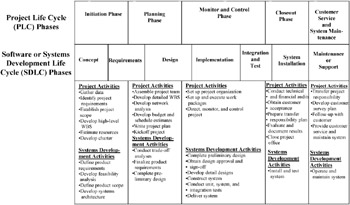The Project and Systems Development Life Cycles
|
Project managers have long known that projects have a life cycle much like a biological life cycle. That is, the project starts slowly, builds steadily to a peak resource and activity level, and then rapidly decreases in resources and activity to the closeout point.
There is no standard nomenclature for naming phases. Often, the initiation phase will be called the concept phase. Planning is sometimes called development, monitor and control are often referred to as implementation, and the word termination can replace the term closeout. The phase names I use in this book are chosen as a convenient way to differentiate between the project and systems life cycles, but you or your organization may use a different set of names. The important point to remember is that the activities, regardless of the phase name, are the same.
The project life cycle shown in Exhibit 3-1 is typical of an IT project. However, different types of projects can and often do have more or fewer phases than these. For example, a research project might have basic research and proof-of-concept phases before the initiation phase. Also, some organizations view certain activities, for example, project selection or customer services, as being life cycle phases, while others do not. Some authorities argue that customer service in particular and system maintenance to a significant degree do not meet the strict definition of a project because these are ongoing activities. However, most IT projects have customer service and maintenance commitments that are contractual, which make them projects. In any event, the long-term customer service and system maintenance activities should be treated as new projects, or as ongoing events. But here, this phase in the life cycle is a legitimate phase because it is the transition between the end of the product development cycle and its following service life.
Exhibit 3-1: Typical IT project life.

The SDLC is an underlying or coincident part of the project life cycle. Note that the SDLC is also used in a software development activity to mean software development life cycle, but the term systems development life cycle is more appropriate to the IT environment because IT is a systems project, not just a software development project.
Many organizations attempt to manage projects using a SDLC model alone, but neither the project life cycle nor the SDLC is solely sufficient to successfully manage a project; both are required, and it is a serious mistake to ignore either. A close study of Exhibit 3-2 (discussed in the next section) should make it clear why both life cycle models are important to project success.
Exhibit 3-2: The project and systems development life cycles and activities.

|
EAN: 2147483647
Pages: 129